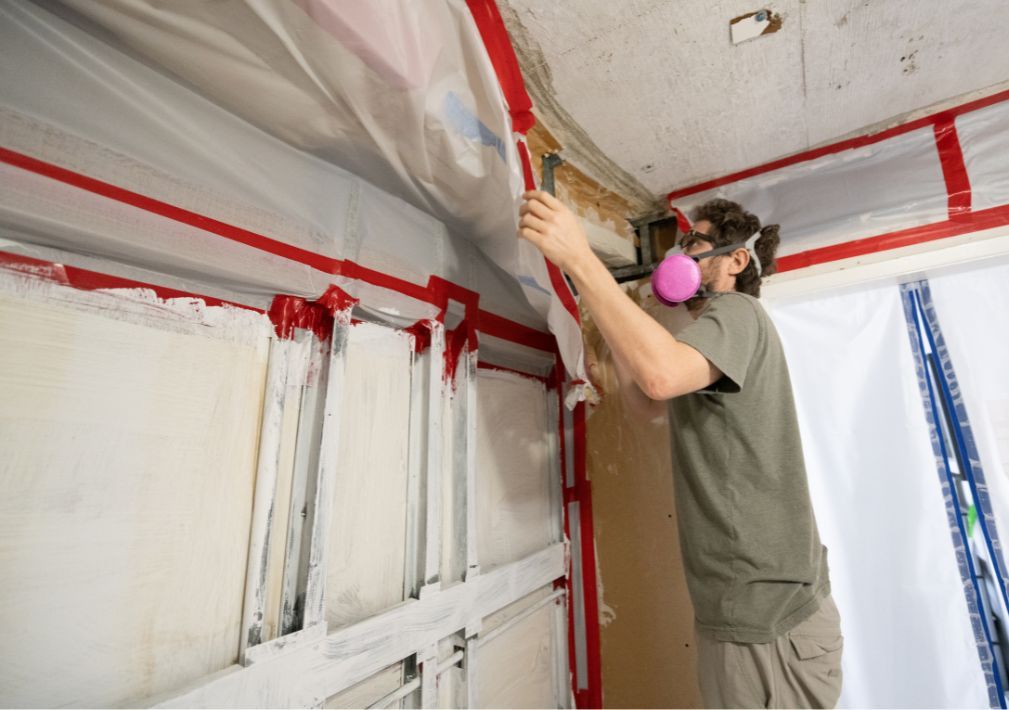Mold Remediation vs. Mold Removal: What’s the Difference?

Mold remediation and mold removal are not the same, mold remediation is a complete, professional approach to identifying, eliminating, and preventing mold growth, while mold removal is often a temporary surface-level cleanup.
If you’re a homeowner dealing with suspicious black spots on the wall, a musty odor in your basement, or water stains on your ceiling, it’s easy to assume a quick scrub will solve the problem. But the reality is more complex. Mold is more than an eyesore; it can cause structural damage and serious health risks if not handled correctly. That’s where understanding the difference between mold remediation and mold removal becomes critical.
What Exactly Is Mold Remediation?
Mold remediation is a comprehensive process performed by certified professionals to remove harmful mold and address the conditions that caused it, ensuring it doesn’t return.
Instead of simply wiping mold away, mold remediation involves:
- Thorough mold inspection using moisture meters and infrared technology
- Identifying moisture sources, such as leaks or humidity pockets
- Containing the area with plastic sheeting and negative air pressure machines
- Removing unsalvageable materials, like mold-infested drywall or insulation
- Air scrubbing and filtration using HEPA filters
- Sanitizing and applying antimicrobial treatments
- Drying the structure to bring relative humidity to safe levels
At Voda Cleaning & Restoration, our mold remediation services are performed using industry-standard protocols (like those outlined by the IICRC) and EPA-approved products to ensure lasting protection. We also advise on long-term moisture prevention strategies, such as ventilation improvements or basement waterproofing.
What Is Mold Removal and Why It Isn’t Enough
Mold removal generally refers to cleaning or scrubbing visible mold from surfaces, usually without addressing its root causes.
While it might seem effective on the surface, mold removal is incomplete and often risky because:
- It does not address hidden mold growing behind walls or under flooring
- It ignores the humidity or leaks that caused the growth
- It fails to trap airborne spores, which can resettle elsewhere
- It increases the chances of cross-contamination if not properly contained
Many homeowners unknowingly turn to DIY mold removal or use bleach-based cleaners that only make the problem worse. Without professional intervention, spores can multiply and spread throughout HVAC systems, attics, and crawlspaces.
Voda Cleaning & Restoration stresses that removal without remediation is like cutting weeds without treating the roots, they’ll just grow back.
Mold Remediation vs. Mold Removal: A Side-by-Side Reality Check
While mold removal may address immediate visibility, mold remediation addresses structural safety, air quality, and long-term prevention.
Here’s what sets them apart:
- Remediation = root cause treatment (moisture, spores, contamination)
- Removal = surface cleaning (visual treatment only)
- Remediation = health-focused approach
- Removal = cosmetic appeal
- Remediation = regulated and methodical
- Removal = often unregulated and temporary
Hiring Voda Cleaning & Restoration for mold remediation ensures you receive a complete solution, not just a bandage for a deeper issue.
When Should You Call for Mold Remediation?
You don’t have to wait until your entire wall is covered in black mold to act. Mold often starts in hidden areas like crawlspaces, behind drywall, and inside vents. Call a professional mold remediation team if you notice:
- Persistent musty odors, even after cleaning
- Peeling paint or warped walls
- Health symptoms like sinus infections, asthma flare-ups, or chronic coughing
- Discoloration on ceilings, baseboards, or tiles
- Past water damage, especially in basements or near plumbing
Voda Cleaning & Restoration offers professional mold testing and remediation solutions designed to detect and treat mold growth at every level of your home or commercial building.
Why Mold Remediation Requires Certified Professionals
Professional mold remediation isn’t just about cleaning, it’s a science-backed method that involves understanding mycology, air flow dynamics, and building materials. Here’s why certified pros matter:
- Safety protocols are essential when handling toxic black mold
- Professionals can identify non-visible mold hotspots using advanced tools
- Mold spores are easily disturbed; trained technicians know how to contain and neutralize them safely
- Mold remediation often involves removing building materials, which should be done by trained professionals to avoid damaging the structure
At Voda Cleaning & Restoration, we use HEPA vacuums, air scrubbers, and antimicrobial fogging to ensure thorough decontamination. We also provide moisture control consultation to prevent future outbreaks, making your home healthier and more energy-efficient.
Why DIY Mold Removal Is a Risk You Shouldn’t Take
While it’s tempting to grab a sponge or spray bottle and “take care” of the mold, doing so can:
- Expose you to airborne toxins
- Spread spores throughout your HVAC system
- Leave behind unseen mold colonies in structural cavities
- Lead to legal issues if you’re selling or renting the property
Voda Cleaning & Restoration strongly advises against DIY mold removal. Hiring a certified remediation expert is not only safer but often more cost-effective in the long run.
The Role of Moisture Control in Mold Remediation
A major component of successful mold remediation is moisture management. Mold needs water to grow, so eliminating moisture is key to preventing recurrence.
Common moisture sources include:
- Roof leaks and poor drainage
- Unventilated bathrooms and kitchens
- Flooding or pipe bursts
- Basement seepage or condensation
- Poor insulation causing temperature differentials
Voda Cleaning & Restoration conducts moisture mapping and provides solutions such as dehumidifier installations, sealing crawlspaces, and repairing water damage to eliminate the conditions mold thrives in.
What to Expect During a Mold Remediation Project
Many homeowners are uncertain about what actually happens during mold remediation. Here’s a step-by-step overview from Voda Cleaning & Restoration:
- Initial assessment with moisture detection and air sampling
- Setting up containment using plastic sheeting and air scrubbers
- Creating negative air pressure to stop mold from spreading
- Removing contaminated materials, including carpets, drywall, or insulation
- Cleaning and disinfecting all affected surfaces
- HEPA vacuuming and air filtration
- Drying the space to return humidity levels to normal
- Post-remediation inspection to verify mold elimination
- Optional repairs and restoration services to rebuild damaged areas
This process is thorough, safe, and aligned with industry best practices for both residential and commercial properties.
How Mold Remediation Protects Indoor Air Quality
One of the most overlooked but crucial aspects of mold remediation is its role in improving indoor air quality. Mold spores are microscopic and can easily become airborne, contaminating the air you and your family breathe. These spores are often invisible and can circulate through HVAC systems, affecting every room in the house.
Without proper mold remediation, airborne spores can lead to persistent respiratory symptoms such as coughing, sneezing, wheezing, or even more severe reactions in individuals with asthma or allergies. Simply scrubbing surfaces or spraying air fresheners doesn’t address the root issue. In fact, improper mold cleanup may increase airborne contaminants.
At Voda Cleaning & Restoration, we prioritize air filtration during every mold remediation project. Using HEPA filters and negative air machines, we trap mold spores before they spread. Our technicians also test air quality post-remediation to ensure a safe and breathable indoor environment for your family, staff, or tenants.
Mold Remediation for Commercial Properties: What Business Owners Need to Know
Mold doesn’t just affect homes, it’s a serious concern for commercial spaces as well. From restaurants and schools to office buildings and retail stores, mold outbreaks can lead to health complaints, failed inspections, and even temporary closures. That’s why mold remediation is just as critical in the commercial sector.
In business environments, mold may originate from leaking roofs, poorly ventilated restrooms, or hidden plumbing issues. When left untreated, it can spread through ventilation systems and settle behind walls or under carpets. This can compromise employee health, damage inventory, and harm your brand’s reputation.
Voda Cleaning & Restoration offers specialized mold remediation for commercial properties, tailored to minimize business disruptions. Our certified technicians conduct discreet inspections, create remediation plans, and coordinate with property managers to ensure efficient and compliant cleanup. Whether it’s an office, warehouse, or multi-unit complex, our mold treatment services are thorough, documented, and insurance-ready, giving business owners confidence and continuity.
The Final Verdict on Mold Remediation vs. Mold Removal
In summary, mold remediation is the only way to effectively protect your property and health from the dangers of mold. Mold removal, while helpful for temporary aesthetic improvement, does not solve the underlying problem and often leads to recurrence.
Whether you’re a homeowner, property manager, or business owner, it’s essential to choose a professional team with experience, training, and the right equipment. Voda Cleaning & Restoration offers full-service mold remediation, including damage assessment, containment, air purification, and preventive solutions.
Call us at (608) 398-8632 or schedule an appointment with Voda Cleaning & Restoration. Get peace of mind knowing your mold problem is being handled the right way, right from the start.
Frequently Asked Questions About Mold Remediation
Can I stay in my home during mold remediation?
In many cases, yes. However, if the affected area is large or near living quarters, temporary relocation may be advised. Voda Cleaning & Restoration will always prioritize your safety and comfort, providing guidance based on the extent of contamination.
Does mold remediation affect my HVAC system?
Yes, especially if the HVAC has been contaminated with mold spores. During remediation, we often inspect and clean ductwork to prevent spores from circulating through your home. Neglecting this step can lead to reinfestation.
How do I know if mold is causing my health symptoms?
While symptoms like headaches, fatigue, sinus issues, or skin irritation can be linked to many conditions, mold exposure is a known trigger. If symptoms improve after leaving the house or worsen in damp areas, mold could be a contributor. Air quality testing from Voda Cleaning & Restoration can help determine the presence of mold spores.
More Blogs
Categories


